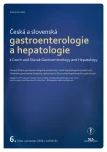-
Medical journals
- Career
Biodegradable stents in benign stenosis of the biliary tract
Authors: J. Hajer; Z. Zádorová; E. Plíšková
Authors‘ workplace: II. interní klinika 3. lékařské fakulty UK a FNKV, Praha
Published in: Gastroent Hepatol 2010; 64(6): 31-34
Category: Endoscopy
Overview
Aim of the Study:
Benign bile duct stenoses are poorly resolvable issues requiring a multidisciplinary approach. They may be asymptomatic, but most often manifest as painless resulting jaundice or associated with signs of cholangitis and liver abscess. The most common causes are due to iatrogenic stenosis as a result of surgery. So far, the only possibility of endoscopic therapy based on the guidelines of the Czech Society of Gastroenterology is multiple introduction of plastic stents. The first attempts to introduce biodegradable stents via the transhepatic route show very positive results. The aim of our study was to evaluate the possibility of a duodenal approach in the implementation of biodegradable stents in the biliary tract.Methods:
Endoscopic installation of biodegradable stent (SX-ELLA Stent DV-uncoated 10 × 60 mm) by using a mother scope (Olympus TJF-20 mother scope). The methodology is similar to standard ERCP.Results and Conclusion:
Self-expandable stents made of biodegradable materials might be a significant benefit in the treatment of benign stenoses of the digestive tract. The main disadvantage is the outer diameter of the boot system, which prevents the use of standard therapeutic duodenoscopes.Key words:
Benign bile duct stenoses – biodegradable stent – ERCP – chronic pancreatitis
Sources
1. Bureš J. Biodegradabilní stenty – Šikovný nástroj k překonání „standardní léčby“ refrakterních stenóz. Folia Gastroenterologica et Hepatologica 2009; 7(1): 4–6.
2. Rejchrt S, Kopáčová M, Bártová J et al. Intestinal biodegradable stents. Inicial expirience in the Czech Republic. Folia Gastroenterologica et Hepatologica 2009; 7(1): 7–11.
3. Meng B, Wang J, Zhu N et al. Study of biodegradable and self-expandable PLLA helical biliary stent in vivo and in vitro. J Mater Sci Mater Med 2006; 17(7): 611–617.
4. Ginsberg G, Cope C, Shah J et al. In vivo evaluation of a new bioabsérbable self-expanding biliary stent. Gastrointestinal endoscopy 2003; 58(5): 777–784.
5. Laukkarinen J, Lämsä T, Nordback I et al. A novel biodegradable pancreatic stent for human pancreatic applications: a preclinical safety study in a large animal model. Gastrointestinal endoscopy 2008; 67(7): 1106–1112.
6. Draganov P, Hoffman B, MarshW et al. Long-term outcome in patiens with benign biliary strictures treated endoscopically with multiple stents. Gastrointestinal endoskopy 2002; 55(6): 680–686.
7. Yamaguchi T, Ishihara T, Seza K et al. Long term outcome of endoscopic metallic stenting for benign biliary stenosis associated with chronic pankreatitis. World J Gastroenterol 2006; 12(3): 426–430.
8. Waksman R. Biodegradable Stents: They Do Their Job and Disappear: Why Bioabsorbable Stents? J Invasive Cardiol 2006; 18(2): 70–74.
Labels
Paediatric gastroenterology Gastroenterology and hepatology Surgery
Article was published inGastroenterology and Hepatology

2010 Issue 6-
All articles in this issue
- The place and detection rates of colonoscopy within a faecal occult blood test-based screening program
- Extraesophageal reflux up-to-date
- Non-steroidal anti-inflammatory drugs induced colopathy, mimicking Crohn’s disease
-
Klíčové otázky a odpovědi v léčbě Crohnovy nemoci
Závěry mezinárodního projektu IBD-AHEAD
- Fertility, pregnancy, breastfeeding and chronic inflammatory bowel diseases – Consensus of the ECCO 2010
- Biodegradable stents in benign stenosis of the biliary tract
- Reflection of UEGW 2010
- Gastroenterology and Hepatology
- Journal archive
- Current issue
- Online only
- About the journal
Most read in this issue- Extraesophageal reflux up-to-date
- Biodegradable stents in benign stenosis of the biliary tract
- Non-steroidal anti-inflammatory drugs induced colopathy, mimicking Crohn’s disease
- Fertility, pregnancy, breastfeeding and chronic inflammatory bowel diseases – Consensus of the ECCO 2010
Login#ADS_BOTTOM_SCRIPTS#Forgotten passwordEnter the email address that you registered with. We will send you instructions on how to set a new password.
- Career

